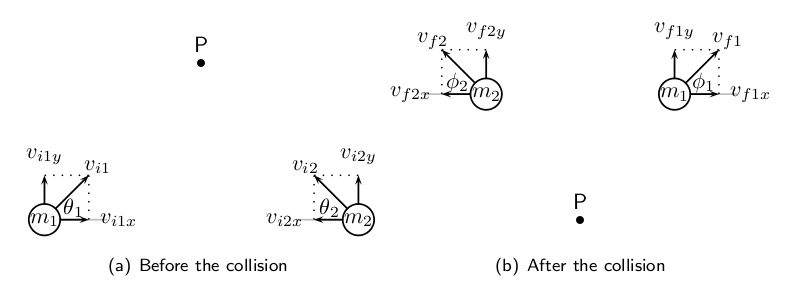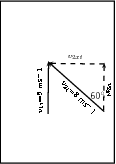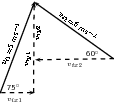| << Chapter < Page | Chapter >> Page > |
We have seen in Grade 11 that the momentum of a system is conserved when there are no external forces acting on the system. Conversely, an external force causes a change in momentum , with the impulse delivered by the force, acting for a time given by:
The same principles that were studied in applying the conservation of momentum to problems in one dimension, can be applied to solving problems in two dimensions.
The calculation of momentum is the same in two dimensions as in one dimension. The calculation of momentum in two dimensions is broken down into determining the and components of momentum and applying the conservation of momentum to each set of components.
Consider two objects moving towards each other as shown in [link] . We analyse this situation by calculating the and components of the momentum of each object.

Total momentum:
-component of momentum:
-component of momentum:
Total momentum:
-component of momentum:
-component of momentum:
The initial momentum is equal to the final momentum:
This forms the basis of analysing momentum conservation problems in two dimensions.
Phet simulation for momentum
In a rugby game, Player 1 is running with the ball at 5 m s straight down the field parallel to the edge of the field. Player 2 runs at 6 m s an angle of to the edge of the field and tackles Player 1. In the tackle, Player 2 stops completely while Player 1 bounces off Player 2. Calculate the velocity (magnitude and direction) at which Player 1 bounces off Player 2. Both the players have a mass of 90 kg.
The first step is to draw the picture to work out what the situation is. Mark the initial velocities of both players in the picture.

We also know that kg and = 0 ms .
We need to find the final velocity and angle at which Player 1 bounces off Player 2.
Total initial momentum = Total final momentum. But we have a two dimensional problem, and we need to break up the initial momentum into and components.
For Player 1:
For Player 2:
For Player 1:
For Player 2:
The initial total momentum in the direction is equal to the final total momentum in the direction.
The initial total momentum in the direction is equal to the final total momentum in the direction.
If we find the final and components, then we can find the final momentum.
Use Pythagoras's theorem to find the total final velocity:

Calculate the angle to find the direction of Player 1's final velocity:
Therefore Player 1 bounces off Player 2 with a final velocity of 11.36 m at an angle of 52.4 from the horizontal.
In a soccer game, Player 1 is running with the ball at 5 m s across the pitch at an angle of from the horizontal. Player 2 runs towards Player 1 at 6 m s an angle of to the horizontal and tackles Player 1. In the tackle, the two players bounce off each other. Player 2 moves off with a velocity in the opposite -direction of 0.3 m s and a velocity in the -direction of 6 m s . Both the players have a mass of 80 kg.What is the final total velocity of Player 1?
The first step is to draw the picture to work out what the situation is. Mark the initial velocities of both players in the picture.

We need to define a reference frame: For y, choose the direction they are both running in as positive. For x, the direction player 2 is running in is positive.
We also know that kg. And =-0.3 ms and =6 ms .
We need to find the final velocity and angle at which Player 1 bounces off Player 2.
Total initial momentum = Total final momentum. But we have a two dimensional problem, and we need to break up the initial momentum into and components. Remember that momentum is a vector and has direction which we will indicate with a '+' or '-' sign.
For Player 1:
For Player 2:
For Player 1:
For Player 2:
The initial total momentum in the direction is equal to the final total momentum in the direction.
The initial total momentum in the direction is equal to the final total momentum in the direction.
If we find the final and components, then we can find the final momentum.
Use Pythagoras's theorem to find the total final velocity:

Calculate the angle to find the direction of Player 1's final velocity:
Therefore Player 1 bounces off Player 2 with a final velocity of 4.5 m at an angle of 63.4 from the horizontal.

Notification Switch
Would you like to follow the 'Siyavula textbooks: grade 12 physical science' conversation and receive update notifications?